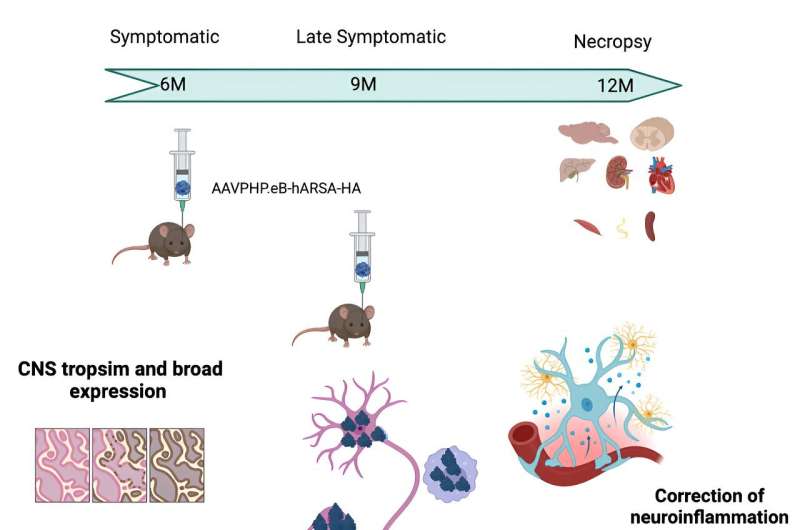This article has been reviewed according to Science X's editorial process and policies. Editors have highlighted the following attributes while ensuring the content's credibility:
fact-checked
trusted source
proofread
New gene therapy for metachromatic leukodystrophy proves effective in mice

Metachromatic leukodystrophy is a rare genetic disorder that mainly affects young children and results in severe neurological symptoms accompanied by a loss of motor and intellectual capacities. At Paris Brain Institute, Françoise Piguet and her colleagues have developed a gene therapy treatment capable of correcting the primary anomaly observed in the disease: the accumulation of sulfatides in the brain and spinal cord. Effective in mice, as shown by results published in Molecular Therapy—Methods & Clinical Development, this technique paves the way for clinical trials.
Metachromatic leukodystrophy affects between one and nine people out of 100,000 and manifests itself mainly in childhood and adolescence—with 10 to 20% of cases observed in adulthood. The disease is hereditary but requires both parents to carry the mutated ARSA gene, which controls the production of the enzyme arylsulfatase A.
The depletion of this enzyme in the body leads to an abnormal accumulation of specific lipids (sulfatides) in the white matter of the central nervous system, peripheral nerves, kidneys and gallbladder.
The consequence? A loss of the myelin sheath, which ensures proper conduction of nerve signals in the brain and spinal cord, and an acute inflammatory response that damages nerve cells. As a result, patients experience severely debilitating symptoms such as movement, vision and hearing disorders, a deterioration in intellectual abilities and difficulty expressing themselves.
Metachromatic leukodystrophy progresses particularly rapidly in children and leads to premature death, hence the urgent need to develop effective treatments.
"For these young patients whose symptoms have already set in, gene therapy—which involves injecting a healthy gene into the body using a harmless virus—is a very promising way of delaying or halting the progression of the disease," Françoise Piguet, a researcher and head of the Genov innovation and technological development unit at Paris Brain Institute, explains.
"This technique makes it possible to make nerve cells express the protein lacking—in this case, the enzyme arylsulfatase A." However, a crucial constraint must be overcome for in vivo gene therapy to be effective: allowing the cargo of genetic material to cross the blood-brain barrier, which prevents unwanted substances circulating in the blood from reaching the brain.
Tackling the blood-brain barrier
For their study, Françoise Piguet and her team chose a specific type of "adeno-associated" virus (AAVPHP.eB) whose properties enable it to cross this barrier easily and is harmless for the body. The researchers used it as a vector—or as a vehicle—to carry a copy of the functional ARSA gene into the brains of mice in which this gene was deficient.
"We administered the drug-gene to six-month-old mice and then to nine-month-old mice with more severe symptoms," Françoise Piguet adds. "The effects of the treatment were then assessed three and six months after each injection."
The researchers' results are very encouraging. The healthy gene successfully spread to the target neuron population, which began secreting the precious enzyme and correcting the activity of nearby cells—including myelin-producing oligodendrocytes. The result? Sulfatide levels returned to normal, and neuroinflammation was significantly reduced in the brain and spinal cord, even in the nine-month-old mice with more advanced disease.
"These data are robust enough that we can now evaluate the treatment in primates to organize clinical trials in humans later," the researcher concludes. "Metachromatic leukodystrophy sets in rapidly in young children, and gene therapy must stop the abnormal accumulation of sulfatides almost immediately. All our efforts are devoted to achieving this goal."
More information: Emilie Audouard et al, Dose-response evaluation of intravenous gene therapy in a symptomatic mouse model of metachromatic leukodystrophy, Molecular Therapy - Methods & Clinical Development (2024). DOI: 10.1016/j.omtm.2024.101248





















